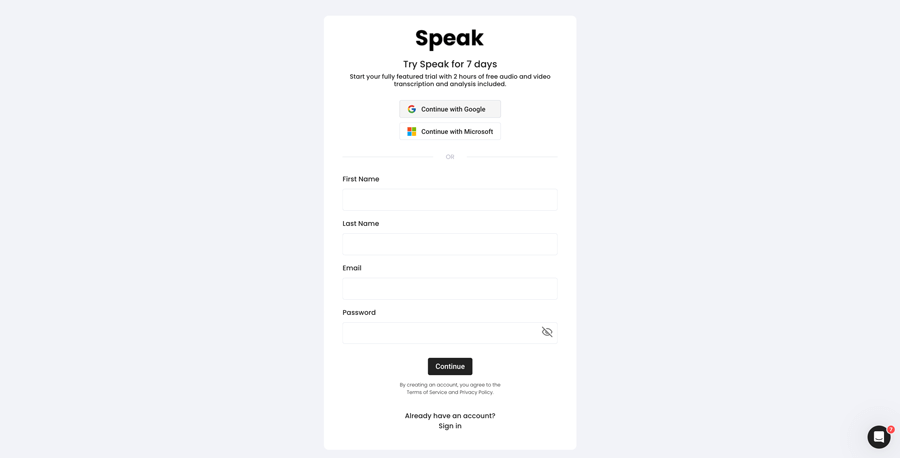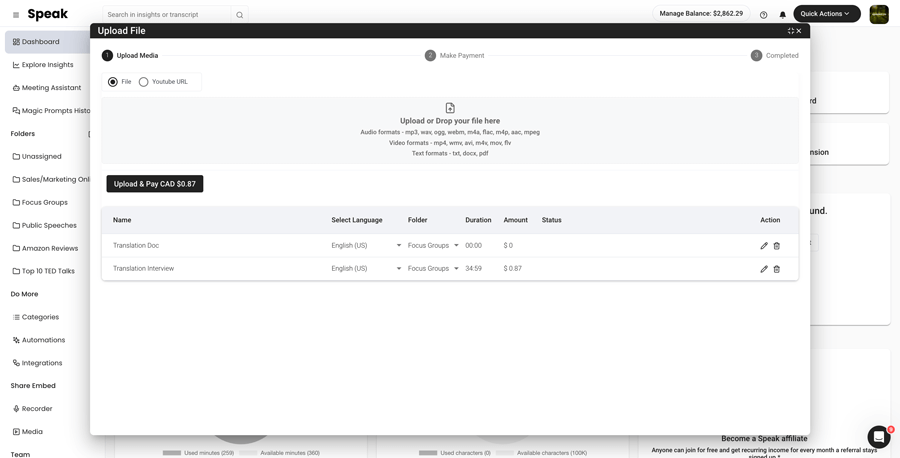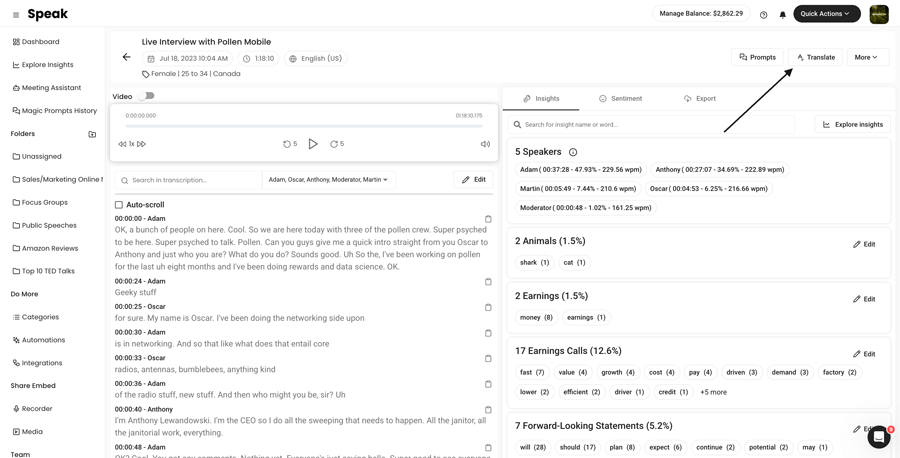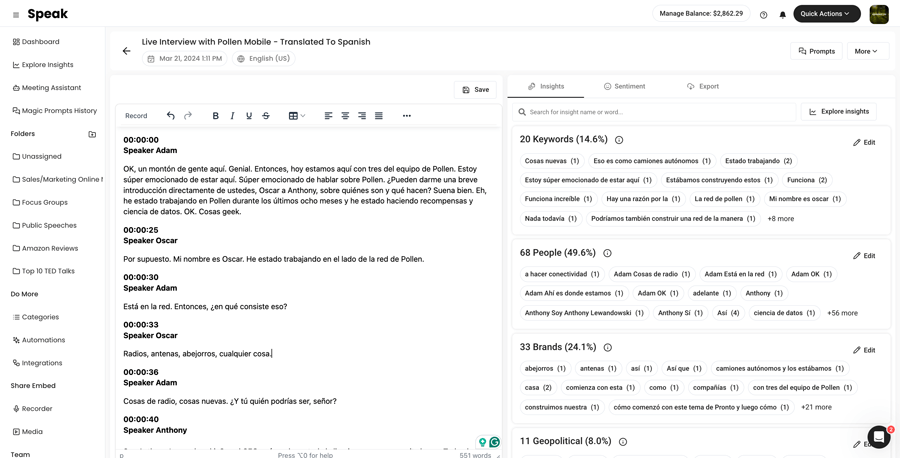How To Translate Japanese to Vietnamese
Translating Japanese to Vietnamese is super simple!

Step 1: Register for Speak
Register for Speak using this link.
Once you register, you can instantly begin translating your Japanese to Vietnamese file(s).

Step 2: Upload Your Japanese file(s)
As soon as you log in, you will be redirected to the dashboard.
Once there, you can select the Quick Action "New Upload".
In Speak, you can seamlessly upload, transcribe and translate audio, video and text files all at once!

Step 3: Translate Your Japanese file(s) to Vietnamese
Once the file is uploaded, simply visit your file and select "Translate".
If it is an audio and video file, Speak will ask you if you want to keep the speaker names and timestamps in the translation.
Want to translate many files at once? No problem!
You can view the files you want to automatically translate from Japanese to Vietnamese from the folder level and instantly translate as many files as you need with our artificial intelligence translation in just a few clicks.

Step 4: That's It! View, Analyze, Modify & Export Your New Vietnamese file(s)
Once the translation is done, you will be alerted and you will see a new document in the same folder your original file is in.
The file will be named the same but with a dash indicating that it is the translated version.
Need support with your Japanese translation?
We are always here and happy to help at Speak!
Just send us a message on live chat on the bottom right corner and we will ensure you are set up for success.
Interested in translating Japanese or other languages to different languages? View our entire list of supported translation languages here.
Automatic, accurate, instant AI translation from Japanese to Vietnamese is here for you.
Register for Speak using this link and begin translating Japanese to Vietnamese today.
Unlock the Power of Seamless Communication: Translate Japanese to Vietnamese
In today's globalized world, where barriers are constantly being broken down by technology, the ability to communicate across languages holds the key to unlocking endless opportunities. Speak AI, leveraging cutting-edge NLP, large language models, and generative AI, introduces an efficient and transformative way to translate Japanese to Vietnamese, bridging the gap between these rich cultures and enabling businesses and researchers to reach a wider audience. With over 150K users and a stellar 4.9 rating on G2, discover the unparalleled advantages of using our AI-powered translation services.
Why Translate Japanese to Vietnamese: A Strategic Move for Global Expansion
With the ASEAN region's burgeoning market and the historical ties between Japan and Vietnam, the need for seamless translation between Japanese and Vietnamese has never been more critical. From academic research to business contracts, translating documents, audio, and video files accurately can significantly enhance understanding and cooperation, propelling your endeavors to new heights.
Use Cases: Beyond Boundaries
-
Business Expansion: Enter and compete in the Vietnamese market with your Japanese products and services, understanding and catering to local preferences.
-
Academic Collaboration: Enable joint research and educational projects with effortless exchange of knowledge and resources between Japanese and Vietnamese institutions.
-
Cultural Exchange: Promote tourism and cultural understanding by breaking language barriers, offering translated guides, and facilitating smoother communication.
Benefits: The Speak AI Difference
-
Accuracy: Our technology ensures your Japanese to Vietnamese translations are precise, capturing the nuances of each language.
-
Efficiency: Instant translations save you time, allowing for quick decision-making and faster project completions.
-
Cost-Effectiveness: With automatic translation, reduce the need for expensive human translators for every document or communication.
-
Integration: Speak AI seamlessly integrates with platforms like Microsoft Teams, Zoom, Google Meet, and Webex, enabling real-time translation during meetings and conferences.
How It Works: Transforming Communication with AI
Speak AI uses the latest advancements in artificial intelligence to power its translation services. By employing deep learning algorithms and large language models, it can understand context, detect nuances, and provide translations with a high degree of accuracy. Whether you're translating textual documents, live meetings, or recorded audio and video, Speak AI equips you with the tools you need for effortless communication across languages.
Diving Deeper: Japanese and Vietnamese on the World Stage
Geographical and Cultural Significance
Japanese and Vietnamese languages are not just means of communication but are gateways to understanding the rich histories and cultures of Japan and Vietnam. Japan, with its blend of ancient traditions and modern innovation, and Vietnam, with its dynamic growth and deep cultural roots, both represent significant economic and cultural forces in the Asia-Pacific region.
Interesting Statistics
Japan and Vietnam share strong economic ties, with Japan being among Vietnam's top investors. The flow of trade, tourism, and cultural exchange between these countries highlights the importance of fostering effective communication channels.
Fun Facts and Linguistic Insights
Despite their geographic proximity, Japanese and Vietnamese languages belong to different language families. Yet, both languages share a bond through borrowed words and historical interactions. For instance, the Vietnamese language has absorbed many Sino-Japanese terms over the centuries, reflecting the deep cultural and historical connections between these nations.
Similarities and Differences:
-
Writing Systems: While Japanese uses a mix of kanji and kana, Vietnamese employs the Latin alphabet with diacritics to indicate tones.
-
Grammar: Both languages value politeness and formality in their structure, but they differ significantly in grammar and syntax.
-
Phonetic Tones: Vietnamese is tonal, meaning the tone in which a word is spoken can change its meaning, a feature not present in Japanese.
Empower Your Global Vision with Speak AI
As the world becomes increasingly interconnected, the ability to communicate effectively across languages is paramount. Speak AI's Japanese to Vietnamese translation service is more than just a tool; it's a gateway to unlocking endless possibilities. Whether for business, research, or cultural understanding, Speak AI ensures your message is not just heard but understood. Experience the future of communication with Speak AI and take the first step towards a more connected and integrated world.
Contact us today to learn how Speak AI can transform your communication strategy and help you make a lasting impact on the global stage.
Your Questions Answered
What locations are Japanese and Vietnamese popular?
Japanese is primarily spoken in Japan, where it is the national language. With a population of over 126 million, Japan is a significant cultural and economic powerhouse. Vietnamese, the official language of Vietnam, boasts over 76 million native speakers. Both languages are also spoken by diasporas around the world, particularly in countries like the United States, Canada, and Australia.
What are some fun facts about Japanese and Vietnamese?
Japanese is known for having multiple levels of formality in its language, reflecting the speaker's relationship to the listener. Vietnamese, on the other hand, uses a system of tones — six in total — which can entirely change the meaning of a word based on its intonation.
What are the differences and similarities between Japanese and Vietnamese?
While starkly different in structure and origin, Japanese and Vietnamese share cultural exchanges that have influenced their languages. Both prioritize respect and formality, affecting not just their grammatical structures but the ethos behind communication. However, they diverge significantly in pronunciation, writing systems, and syntax, underlining the importance of accurate translation services to preserve the integrity and nuance of each language.
Translate Japanese To These Other Supported Languages:
- Translate Japanese-to-Arabic (Egypt)
- Translate Japanese-to-Arabic (Iraq)
- Translate Japanese-to-Arabic (Israel)
- Translate Japanese-to-Arabic (Jordan)
- Translate Japanese-to-Arabic (Kuwait)
- Translate Japanese-to-Arabic (Lebanon)
- Translate Japanese-to-Arabic (Oman)
- Translate Japanese-to-Arabic (Palestinian Authority)
- Translate Japanese-to-Arabic (Qatar)
- Translate Japanese-to-Arabic (Saudi Arabia)
- Translate Japanese-to-Arabic (Syrian Arab Republic)
- Translate Japanese-to-Arabic (United Arab Emirates)
- Translate Japanese-to-Arabic Modern Standard (Bahrain)
- Translate Japanese-to-Armenian
- Translate Japanese-to-Bulgarian
- Translate Japanese-to-Catalan
- Translate Japanese-to-Chinese (Cantonese, Traditional)
- Translate Japanese-to-Chinese (Simplified)
- Translate Japanese-to-Chinese (Traditional)
- Translate Japanese-to-Croatian
- Translate Japanese-to-Czech
- Translate Japanese-to-Danish
- Translate Japanese-to-Dutch
- Translate Japanese-to-English
- Translate Japanese-to-English (Australia)
- Translate Japanese-to-English (India)
- Translate Japanese-to-English (Ireland)
- Translate Japanese-to-English (New Zealand)
- Translate Japanese-to-English (Scottish)
- Translate Japanese-to-English (South African)
- Translate Japanese-to-English (United Kingdom)
- Translate Japanese-to-English (United States)
- Translate Japanese-to-Estonian
- Translate Japanese-to-Farsi
- Translate Japanese-to-Finnish
- Translate Japanese-to-French
- Translate Japanese-to-French (Canada)
- Translate Japanese-to-German
- Translate Japanese-to-German (Swiss)
- Translate Japanese-to-Greek
- Translate Japanese-to-Gujarati
- Translate Japanese-to-Hebrew
- Translate Japanese-to-Hindi
- Translate Japanese-to-Hungarian
- Translate Japanese-to-Icelandic
- Translate Japanese-to-Indonesian
- Translate Japanese-to-Irish
- Translate Japanese-to-Italian
- Translate Japanese-to-Japanese
- Translate Japanese-to-Kannada
- Translate Japanese-to-Korean
- Translate Japanese-to-Latvian
- Translate Japanese-to-Lithuanian
- Translate Japanese-to-Malay
- Translate Japanese-to-Malayalam
- Translate Japanese-to-Norwegian
- Translate Japanese-to-Persian
- Translate Japanese-to-Polish
- Translate Japanese-to-Portuguese
- Translate Japanese-to-Portuguese (Brazilian)
- Translate Japanese-to-Portuguese (Portugal)
- Translate Japanese-to-Romanian
- Translate Japanese-to-Russian
- Translate Japanese-to-Slovak
- Translate Japanese-to-Slovenian
- Translate Japanese-to-Spanish
- Translate Japanese-to-Spanish (Mexico)
- Translate Japanese-to-Swedish
- Translate Japanese-to-Tamil
- Translate Japanese-to-Telugu
- Translate Japanese-to-Thai
- Translate Japanese-to-Turkish
- Translate Japanese-to-Ukrainian
- Translate Japanese-to-Vietnamese



